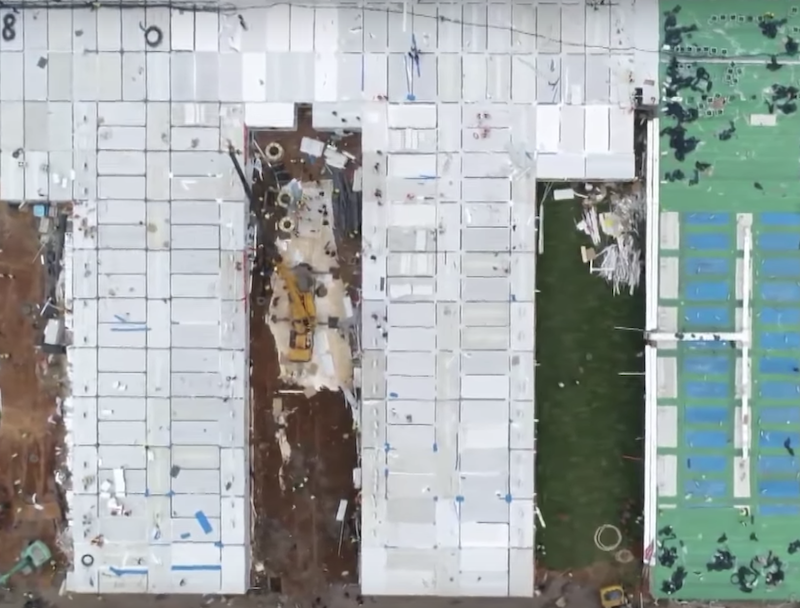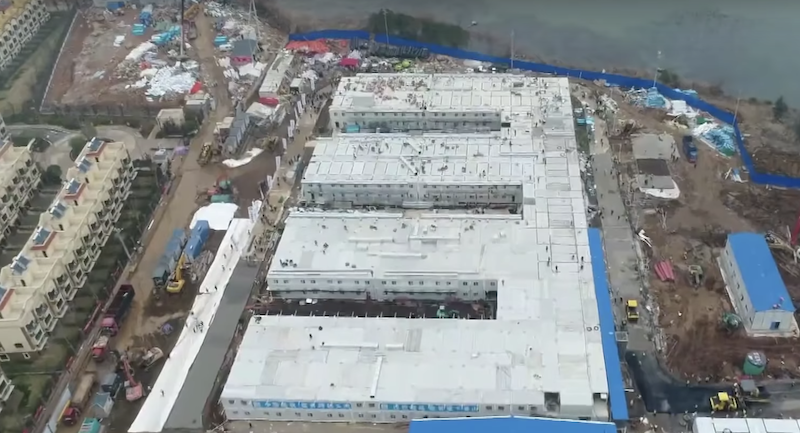A new hospital in Wuhan, China, built to treat patients of the coronavirus outbreak, has finished construction in just 10 days, according to an Associated Press article.
The 645,000-sf Huoshenshan Hospital relied on the use of prefabricated rooms and 7,000 engineers, carpenters, electricians, plumbers, and other tradesmen working around the clock to complete the project so quickly. The two-story, 1,000-bed facility houses patient wards, which includes isolation wards and 30 intensive-care units; bathrooms; doctor rooms, and nurse stations, the Associated Press said, citing China’s Yangtze Daily newspaper.

Specialized ventilation systems and double-sided cabinets that connect patient rooms to hallways allow staff to bring supplies to patients without having to enter the rooms. Infrared scanners will warn if any staff members show signs of fever. A video system, installed in fewer than 12 hours, will allow doctors to talk with experts in Beijing’s PLA General Hospital.
See Also: The complex dance of healthcare transitioning
A second facility, the 1,500-bed Leishenshan Hospital, is set to open Wednesday after beginning construction on Jan. 27.
Related Stories
| Sep 29, 2014
10 common deficiencies in aging healthcare facilities
VOA's Douglas King pinpoints the top issues that arise during healthcare facilities assessments, including missing fire/smoke dampers, out-of-place fire alarms, and poorly constructed doorways.
| Sep 25, 2014
Look to history warily when gauging where the construction industry may be headed
Precedents and patterns may not tell you all that much about future spending or demand.
| Sep 24, 2014
Architecture billings see continued strength, led by institutional sector
On the heels of recording its strongest pace of growth since 2007, there continues to be an increasing level of demand for design services signaled in the latest Architecture Billings Index.
| Sep 23, 2014
Cedars-Sinai looks to streamline trauma care with first-of-its-kind OR360 simulation space
The breakthrough simulation center features moveable walls and a modular ceiling grid that allow doctors and military personnel to easily reconfigure the shape and size of the space.
| Sep 22, 2014
4 keys to effective post-occupancy evaluations
Perkins+Will's Janice Barnes covers the four steps that designers should take to create POEs that provide design direction and measure design effectiveness.
| Sep 22, 2014
Sound selections: 12 great choices for ceilings and acoustical walls
From metal mesh panels to concealed-suspension ceilings, here's our roundup of the latest acoustical ceiling and wall products.
| Sep 20, 2014
Healthcare conversion projects: 5 hard-earned lessons from our experts
Repurposing existing retail and office space is becoming an increasingly popular strategy for hospital systems to expand their reach from the mother ship. Our experts show how to avoid the common mistakes that can sabotage outpatient adaptive-reuse projects.
| Sep 19, 2014
8 hot healthcare projects win interior design awards
Winners of IIDA's 2014 Healthcare Interior Design Competition include Perkins+Will, AECOM, Buffalo Design, and SmithGroupJJR, for projects from Cincinnati to Toronto.
| Sep 15, 2014
Ranked: Top international AEC firms [2014 Giants 300 Report]
Parsons Brinckerhoff, Gensler, and Jacobs top BD+C's rankings of U.S.-based design and construction firms with the most revenue from international projects, as reported in the 2014 Giants 300 Report.
| Sep 15, 2014
Perkins+Will unveils design for Ghana's largest hospital
The new hospital will be home to numerous hospital services including public health, accident and emergency, imaging, obstetrics, gynecology, dental, surgical, intensive care and administration.
















